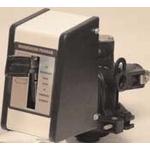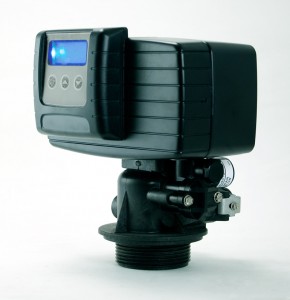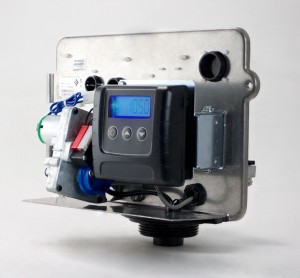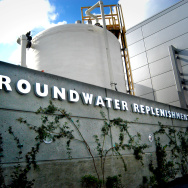How Backwashing Filter Controls Work
by Gene Franks
Large tank-style water filters that have the ability to clean and renew their filter media bed are called backwashing filters. Backwashing is the process by which water is run backward through the filter bed from bottom to top, lifting and tumbling the media, rinsing away impurities and allowing the bed to resettle without channels created while the filter was in service. After the backwash operation, the filter is rinsed by running water rapidly downward through the media bed and out the drain, resettling and packing the bed before it is returned to service.
Although these simple functions of backwash followed by rinse are essentially the same regardless of the control mechanism that performs them, there is a surprising variety of filter control valve styles. The table below shows the two most basic series of Fleck controls (5600 and 2510). Note that these are filter valves and that similar but different controls are required to run water softeners. Prices are Pure Water Products’ current filter prices and are given for cost comparison.
Fleck Filter Control Valve Prices
|
Fleck Control Valve |
Current Price |
Comments |
|
Fleck 5600 Standard Timer |
$223.00 |
Probably the most popular filter valve in the US. |
|
Fleck 5600 SXT Timer |
$268.00 |
|
|
Fleck 5600 Metered SXT (softener and filter) |
$337.00 |
|
|
Fleck 5600 AIO Electronic Aerator Control |
$385.00 |
|
|
Fleck 2510 Manual Control |
$168.00 |
|
|
Fleck 2510 Standard Timer, without Cover |
$281.00 |
Cover: $31 |
|
Fleck 2510 SXT Timer, without Cover |
$328.00 |
Cover: $31 |
|
Fleck 2510 Metered SXT (softener and filter) |
$399.00 |
Cover: $31 |
|
Fleck 2510 AIO Electronic Aerator Control |
$449.00 |
Cover Included. |
Function
Here is a concise description of what these controls do, beginning with the most basic.
Fleck’s Simple 2510 Manual Control. No Electricity Required. It Isn’t Sexy, But It’s Very Functional.
Fleck 2510 Manual. This is the most basic of filter valves, yet in many situations it can be the best. In spite of the low price, it’s a tough and durable piece of equipment. The 2510 Manual is a non-electric control that requires manual backwash and rinse. It is, therefore, not practical if backwashing needs to be performed daily (as with many iron filters, for example), but for a clean city water application where chlorine removal is the main purpose, a monthly backwash is sufficient and performing it can be a 15-minute task. The valve operates with a simple selection lever and has only three choices: Service (means the filter is in service, providing water for the home), backwash, and rinse. Performing the backwash and rinse is like shifting gears in an car: pull the lever to backwash and let it run for five to ten minutes, pull it down to rinse for a couple of minutes, then return it to service.
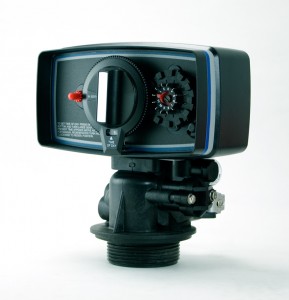 Fleck 5600 Standard Timer Control. America’s Most Popular Water Filter Controller
Fleck 5600 Standard Timer Control. America’s Most Popular Water Filter Controller
Standard Timer models are available in both 2510 and 5600. The 5600 timer is most most widely used filter control in the United States and is sold under the manufacturer’s name as well as many “private label” brands. The user needs only select the days the filter will backwash (the most common format has a 12-Day-Clock) and set the time of day. On the 2510 model, the duration of backwash and rinse can also be changed in two-minute increments. Regeneration times are preset but can be changed by lying to the timer about the time of day.
Fleck 5600 SXT Timer.
SXT Timer. SXT controls feature a simple electronic face and allow easy programming of the basic functions of the filter. They have the advantage over the standard timer of much greater flexibility in setting up regeneration schedules and length of backwash and rinse. A simple 5600 timer, for example, has a pre-set backwash duration, but with the SXT unit the user can choose and easily change the duration of backwash and rinse or the time that they occur. If the power goes off, the user has only to reset the time of day: the computer remembers the programmed settings.
This control system counts time, not gallons used. The metered system below keeps count of both time and gallons used.
Fleck 2510 Metered SXT Can Control a Filter or a Water Softener. Shown without Protective Cover, which is sold separately.
SXT Meter Available in both 2510 and 5600 Formats. This controller is much more frequently used to control water softeners than filters, but it can be easily adapted for use with a filter by simply shortening or turning off functions like “brine draw” and “brine refill” that apply only to softeners. The control system offers much more programming variety. A sediment filter, for example, could be set up to regenerate after every 1000 gallons of service water but to not allow more that 7 days to pass without regeneration. This system offers more complexity than most filters need, but it works great where precise control of gallon usage is required.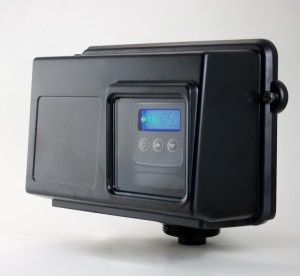
Fleck 2510 AIO Control Valve with Environmental Cover. This is a specialty valve used only on “single tank aeration” filters.
Fleck AIO Electronic Timer Aerator Control. Available in both 2510 and 5600 Formats. The AIO is a specialty product designed specifically to control single tank aeration filters for iron and hydrogen sulfide treatment. It is a very simple electronic timer that keeps time of day and days between regeneration. Its uniqueness is that it is set up to draw air into the filter for oxidation of iron and hydrogen sulfide during the phase where a softener control would normally bring in water for the making of brine. This is a very effective product with a limited application. Programming is simple with only the time of day and the day of regeneration needing attention.




